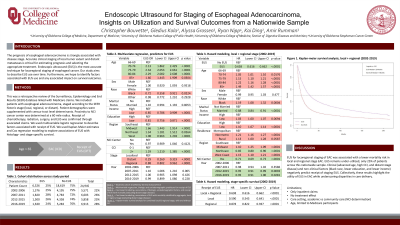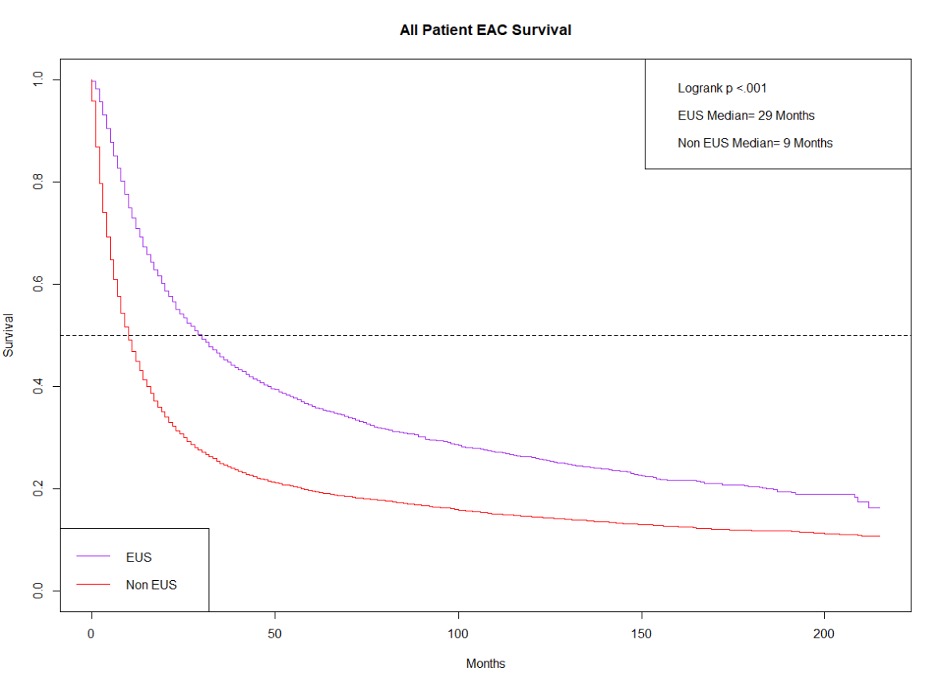Tuesday Poster Session
Category: Interventional Endoscopy
P4486 - Endoscopic Ultrasound for Staging of Esophageal Adenocarcinoma: Insights on Utilization and Survival Outcomes From a Nationwide Sample
Tuesday, October 29, 2024
10:30 AM - 4:00 PM ET
Location: Exhibit Hall E

Has Audio
- CB
Christopher A. Bouvette, MD
University of Oklahoma College of Medicine
Oklahoma City, OK
Presenting Author(s)
Christopher A. Bouvette, MD1, Gledius Kola, MS2, Alyssa Grossen, MD1, Ryan Nipp, MD, MPH1, Kai Ding, PhD3, Amir Rumman, MD1
1University of Oklahoma College of Medicine, Oklahoma City, OK; 2University of Oklahoma Health Sciences Center, Oklahoma City, OK; 3Oklahoma University Health Sciences Center, Oklahoma City, OK
Introduction: The prognosis of esophageal adenocarcinoma is strongly associated with disease stage. Accurate clinical staging of local tumor extent and distant metastases is critical for estimating prognosis and selecting the appropriate treatment. This study aims to describe EUS use over time. Furthermore, we hope to identify factors associated with EUS use and any associated impact on survival outcomes.
Methods: This was a retrospective review of the Surveillance, Epidemiology and End Results (SEER) database linked with Medicare claims. We included patients with esophageal adenocarcinoma, staged according to the SEER historic stage (local, regional, or distant). Receipt of chemotherapy, radiation, surgery, and EUS was confirmed through associated claims. We used multivariable logistic regression to describe factors associated with receipt of EUS. We used Kaplan- Meier estimates and Cox regression modeling to explore associations of EUS with histology- and stage-specific survival.
Results: Overall, 24,945 patients were included in this analysis. Only 25% of patients received EUS. Factors significantly (p< 0.0001) associated with decreased likelihood of receiving EUS included: age over 85 years (OR 0.63), black race (OR 0.75), lower income (OR 0.84), lower education (OR 0.81), distant stage (0.45), and not receiving surgery (OR 0.29), chemotherapy (OR 0.64), or radiation therapy (OR 0.55). Factors significantly (p< 0.0001) associated with increased likelihood of receiving EUS included: patients with Charleston Comorbidity Index (CCI) of 2 or higher (OR 1.40) and residence in the Midwest or Northeast (OR 1.67 and 1.45, respectively). Patients who received EUS had a significantly higher median survival compared to patients that did not receive EUS (29 vs 9 months, logrank p< 0.001, Figure 1). When excluding patients with distant disease, Cox regression modeling for local or regional stage EAC demonstrated a lower mortality risk associated with receipt of EUS (HR 0.71, p< 0.0001).
Discussion: EUS for locoregional staging of EAC was associated with a lower mortality risk in local and regional stage EAC. EUS remains under-utilized, only 25% of patients across this nationwide sample. Clinical (advanced age, low CCI, and distant stage disease) and non-clinical factors (black race, lower education, and lower income) negatively predict receipt of staging EUS. Collectively, these results highlight the utility of EUS in EAC while underscoring disparities in care delivery.

Disclosures:
Christopher A. Bouvette, MD1, Gledius Kola, MS2, Alyssa Grossen, MD1, Ryan Nipp, MD, MPH1, Kai Ding, PhD3, Amir Rumman, MD1. P4486 - Endoscopic Ultrasound for Staging of Esophageal Adenocarcinoma: Insights on Utilization and Survival Outcomes From a Nationwide Sample, ACG 2024 Annual Scientific Meeting Abstracts. Philadelphia, PA: American College of Gastroenterology.
1University of Oklahoma College of Medicine, Oklahoma City, OK; 2University of Oklahoma Health Sciences Center, Oklahoma City, OK; 3Oklahoma University Health Sciences Center, Oklahoma City, OK
Introduction: The prognosis of esophageal adenocarcinoma is strongly associated with disease stage. Accurate clinical staging of local tumor extent and distant metastases is critical for estimating prognosis and selecting the appropriate treatment. This study aims to describe EUS use over time. Furthermore, we hope to identify factors associated with EUS use and any associated impact on survival outcomes.
Methods: This was a retrospective review of the Surveillance, Epidemiology and End Results (SEER) database linked with Medicare claims. We included patients with esophageal adenocarcinoma, staged according to the SEER historic stage (local, regional, or distant). Receipt of chemotherapy, radiation, surgery, and EUS was confirmed through associated claims. We used multivariable logistic regression to describe factors associated with receipt of EUS. We used Kaplan- Meier estimates and Cox regression modeling to explore associations of EUS with histology- and stage-specific survival.
Results: Overall, 24,945 patients were included in this analysis. Only 25% of patients received EUS. Factors significantly (p< 0.0001) associated with decreased likelihood of receiving EUS included: age over 85 years (OR 0.63), black race (OR 0.75), lower income (OR 0.84), lower education (OR 0.81), distant stage (0.45), and not receiving surgery (OR 0.29), chemotherapy (OR 0.64), or radiation therapy (OR 0.55). Factors significantly (p< 0.0001) associated with increased likelihood of receiving EUS included: patients with Charleston Comorbidity Index (CCI) of 2 or higher (OR 1.40) and residence in the Midwest or Northeast (OR 1.67 and 1.45, respectively). Patients who received EUS had a significantly higher median survival compared to patients that did not receive EUS (29 vs 9 months, logrank p< 0.001, Figure 1). When excluding patients with distant disease, Cox regression modeling for local or regional stage EAC demonstrated a lower mortality risk associated with receipt of EUS (HR 0.71, p< 0.0001).
Discussion: EUS for locoregional staging of EAC was associated with a lower mortality risk in local and regional stage EAC. EUS remains under-utilized, only 25% of patients across this nationwide sample. Clinical (advanced age, low CCI, and distant stage disease) and non-clinical factors (black race, lower education, and lower income) negatively predict receipt of staging EUS. Collectively, these results highlight the utility of EUS in EAC while underscoring disparities in care delivery.

Figure: Figure 1
Disclosures:
Christopher Bouvette indicated no relevant financial relationships.
Gledius Kola indicated no relevant financial relationships.
Alyssa Grossen indicated no relevant financial relationships.
Ryan Nipp indicated no relevant financial relationships.
Kai Ding indicated no relevant financial relationships.
Amir Rumman indicated no relevant financial relationships.
Christopher A. Bouvette, MD1, Gledius Kola, MS2, Alyssa Grossen, MD1, Ryan Nipp, MD, MPH1, Kai Ding, PhD3, Amir Rumman, MD1. P4486 - Endoscopic Ultrasound for Staging of Esophageal Adenocarcinoma: Insights on Utilization and Survival Outcomes From a Nationwide Sample, ACG 2024 Annual Scientific Meeting Abstracts. Philadelphia, PA: American College of Gastroenterology.
